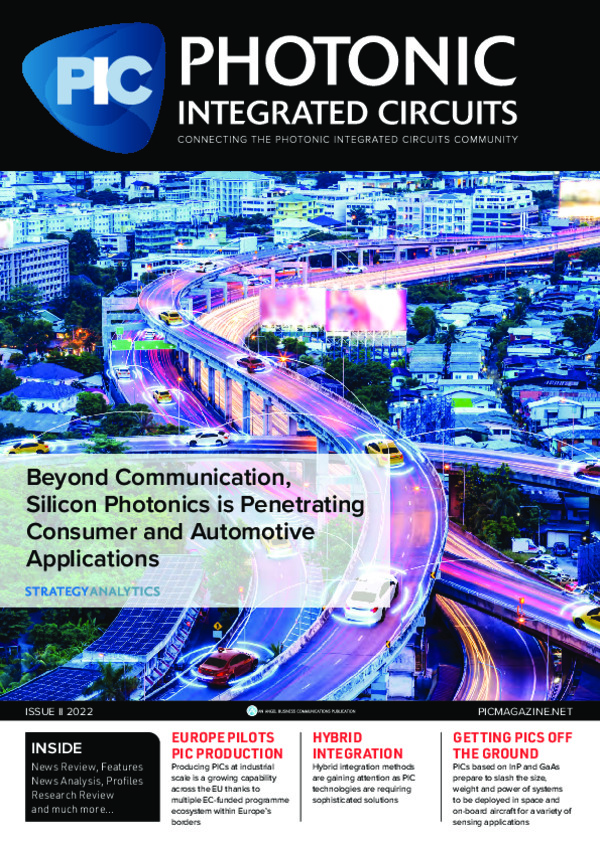
Beyond Communication, Silicon Photonics Is Penetrating Consumer and Automotive Applications

The
strong pull from communications opportunities has allowed the photonics
industry to look at adjacent applications that will benefit from the
advantages of silicon photonics and photonic integrated circuits. LiDAR
in automotive applications is becoming one of the more exciting adjacent
applications for photonics as that industry evolves toward more
autonomous content and capability.
Eric Higham, Director – Advanced Semiconductor Applications/Advanced Defense Applications, Strategy Analytics
As global economies continue to recover from COVID and the pace of events around the world quickens, the importance of broadband connectivity is clear. Countries are expanding their broadband footprints and users are clamoring for higher data rates to accommodate their growing video and application appetites. The result has been an explosion of data traffic over the past decade. The curves in Figure 1 show an extrapolation of Cisco network data for the next decade and the conclusion is inescapable; data traffic is large and growing quickly.
Figure 1: Data Traffic Projection
The red curve shows IP (Internet Protocol) data traffic and this represents any bit of transmitted data, whether that data is on a wireless or wireline network. This data extrapolation predicts traffic to increase by a factor of 125 times over the forecast period. Even more impressive is the magnitude of data shown by the blue line. This curve represents expected data traffic in data centers. This short-reach data traffic runs between five and six times the magnitude of the IP data and it reflects the increasing importance of data communications as we have become more comfortable with the cloud and the home becomes the center of many of our interactions with the world.
The magnitude of this communications activity is becoming clearer. The emerging 5G wireless standard will drive the entire electronics market with cellular terminals exceeding 1 billion units. There are reports of total optical transceiver shipments reaching 1 billion in the next 5 years and yearly data center port shipments exceeding 60 million in the next couple of years.
This communications opportunity, along with the technical requirements have been instrumental in the development and maturation of silicon photonics and the broader photonics integrated circuits (PIC) ecosystem. While communications opportunities currently drive the optical market, the industry is looking at other fast growth, high volume applications that could benefit from more optical content in devices and networks.
Silicon Photonics
Photonics devices face the same pressures as electronic devices to be smaller and less expensive, with better performance to enable more capabilities. The response to these challenges from optical component manufactures has been more integration. Photonic integrated circuit design and manufacturing techniques have gained traction as the component roadmap evolves to include more electrical and optical functions in an optical module. These modules are a mix of direct and coherent detection schemes and that means a variety of compound semiconductors to optimize the linear functions, along with an increasing amount of digital silicon to increase performance characteristics.
Figure 2: Photonic Integrated Circuit Conceptual Block Diagram
Figure 2 shows a conceptual block diagram of the functions that a photonic integrated circuit must address. As digital processing and control capabilities become more important in optical applications, silicon becomes the natural choice for an integration medium. This allows for relatively low volume opportunities to take advantage of the massive processing and manufacturing infrastructure in place for silicon technologies. Manufacturers are using existing silicon CMOS-based processes for all the functions shown in Figure 2, except for the generation function. Silicon is an indirect bandgap material, so it will not emit photons meaning that the generation function requires another technology. The silicon photonics device becomes a subset of a photonics integrated circuit, with a silicon integrated circuit accomplishing all the required functions except for the laser.
New Market Applications
Broadly, the optical industry is becoming extremely excited about the potential in sensing applications. Automotive platforms are generating significant interest as that industry evolves toward more electric vehicles, more sophisticated ADAS (Advanced Driver Assistance Systems) capabilities and full autonomation. After being hard hit by COVID, the automotive industry is trending toward global sales of 100 million vehicles per year and as Figure 3 shows, sensing and detection opportunities in automobiles are increasing and becoming very sophisticated. Vehicle platforms of assorted sizes and purposes are becoming webs of sensor inputs.
Figure 3: Sensor/Detector Opportunities on an Automobile
The term “sensor” encompasses many distinct functions and technologies. Sensors became increasingly important in automotive applications as vehicles began to incorporate more computerized functions. As semiconductor detection and processing capabilities have improved, the scope of driver assistance has increased. A thorough discussion of the full range of sensor applications and technologies is outside the scope of this discussion, but most vehicles sold today use a combination of cameras, ultrasonic sensors and radar at different frequencies to enable features like adaptive cruise control, parking assistance, automatic emergency braking, and blind spot monitoring. These technologies have advantages and disadvantages and the photonics industry is particularly interested in building on early successes with LiDAR systems to help enable the automotive industry’s evolution to full automation.
LiDAR (Light Detection And Ranging) uses the same principle as Radar (Radio detection and ranging), with both systems emitting an electronic signal and then detecting reflections from objects in the distance. The main difference is a radar signal has a wavelength measured in centimeters, or millimeters, while LiDAR uses light signals with wavelengths in the nanometers. This is important because the resolution of either system is related to the wavelength. The resulting improvement in resolution allows LiDAR systems to map a 3-D image that begins to approach the actual image as shown in Figure 4. By using a rotating transceiver, or multiple transceivers strategically located, the system can create a 360-degree, 3-D image of the vehicle’s surroundings. Of course, there are challenges to LiDAR technology and this is where the silicon photonics industry believes it can add value.
Figure 4: LiDAR-Generated Point Cloud Representation
The first challenge is the appropriate system wavelength. The reflected photons received by the LiDAR system must compete with the ambient lighting to be identified as a signal. Solar irradiance in the 850nm-940nm wavelength range is about three times higher than levels at 1500nm, another popular wavelength. This added solar irradiance translates to system noise, but there is substantial development activity at 850nm and this starts to give us insight into the advantage and opportunity for silicon photonics.
The ability to detect that reflected signal depends on the material characteristics of the sensor. Silicon is responsive at wavelengths up to about 1000 nm, but detection at longer wavelengths requires a compound semiconductor material. Detectors for LiDAR systems have evolved from PIN diodes to avalanche photodiodes to single photon avalanche diodes (SPAD) and silicon photomultipliers (SiPM), with the latter two methods capable of being fabricated into arrays with more capabilities. Despite the challenge posed by higher solar irradiance, wavelengths that can be detected and processed by silicon semiconductors provide cost and performance advantages.
Earlier, we mentioned achieving 360-degree coverage by rotating a LiDAR system and while early versions use this approach, the goal of LiDAR manufacturers is to develop an array approach to steer light beams in azimuth and elevation. MEMs and mirrors, along with liquid crystal metasurfaces are in systems being deployed in systems, but the photonics industry is trying to develop an optical phased array (OPA). Like its RF counterparts, the OPA requires a transmit path that includes a chirped or pulsed laser source, isolators, amplifiers, modulators and splitters, along with a receive path including combiners and a detector. Both paths would also need transmission, filtering and other passive structures and that detected signal would undergo substantial processing to generate a detailed rendering like we see in Figure 4.
Except for the laser, all the necessary functional building blocks exist in process design kits (PDK) at silicon foundries currently doing optical work. The need for a discrete laser using a non-silicon technology is a challenge, but emerging silicon photonics opportunities are already embracing and optimizing this impediment. It represents an acceptable concession to access the large and well-capitalized silicon foundry and packaging industry.
Some observers believe that LiDAR deployment has been slowed by technology limitations. Words like clunky and costly are used to explain this slower than hoped adoption. The solution to these challenges is miniaturizing circuits and footprints through integration and tapping into more cost-effective fabrication and manufacturing technologies. The emerging silicon photonics components industry is addressing all these issues as the ecosystem matures and grows. Those features, coupled with more digital processing power in shrinking silicon nodes makes silicon the likely technology choice to unlock the potential of LiDAR in automotive applications.
LiDAR has also found its way into other commercial applications. Apple includes this feature on a range of its latest devices. The LiDAR feature improves resolution and depth for more lifelike pictures. The capability is becoming important as augmented and virtual reality devices become more popular. LiDAR allows spaces to be mapped before 3-D elements are overlaid. Drones and robots use the technology for more accurate mapping and positioning.
On a broader scale, the ability of silicon to detect at wavelengths less than 1000nm (visible and near-infrared spectrum) makes this an excellent choice for biosensors. This opens a whole host of health applications such as glucose monitoring, early detection of cancer or other infectious diseases, with companies currently developing PIC-based biosensors to develop rapid testing for COVID-19. There is discussion of incorporating these capabilities into smart watches to provide medical telemetry data on a real-time basis. Other applications of the biosensor technology include detecting pollutants in the environment and chemical residues and infectious diseases in the food industry.
Conclusions
As consumers and businesses embrace more sophisticated digital capabilities, data traffic is increasing dramatically. Enabling the magnitude of this traffic explosion means that networks and devices are increasingly turning to optical transmission with that technology’s enormous bandwidth capability. Like any electronics capability, as quantity and capabilities grow, size, weight, cost and performance become increasingly important.
For the optical market, this has meant a growing dependence on photonic integrated circuits that use multiple technologies and a hybrid assembly approach, along with emerging silicon photonics devices that integrate all the required functions except the laser into silicon CMOS technology. The silicon photonics ecosystem is relatively new, but it is maturing quickly and it taps into the large, established CMOS manufacturing infrastructure. While the silicon photonics solution is new, the communications and connectivity applications are not and the size of these market opportunities is a big growth engine for silicon photonics revenue.
The strong pull from communications opportunities has allowed the photonics industry to look at adjacent applications that will benefit from the advantages of silicon photonics and photonic integrated circuits. LiDAR in automotive applications is becoming one of the more exciting adjacent applications for photonics as that industry evolves toward more autonomous content and capability. Automotive volume is large and while there are still challenges to address, the silicon photonics ecosystem is interested and they are developing compelling solutions to these challenges. This combination of a strong growth engine, along with new and emerging automotive and sensor opportunities underpins our bullish outlook for the photonics market.



































